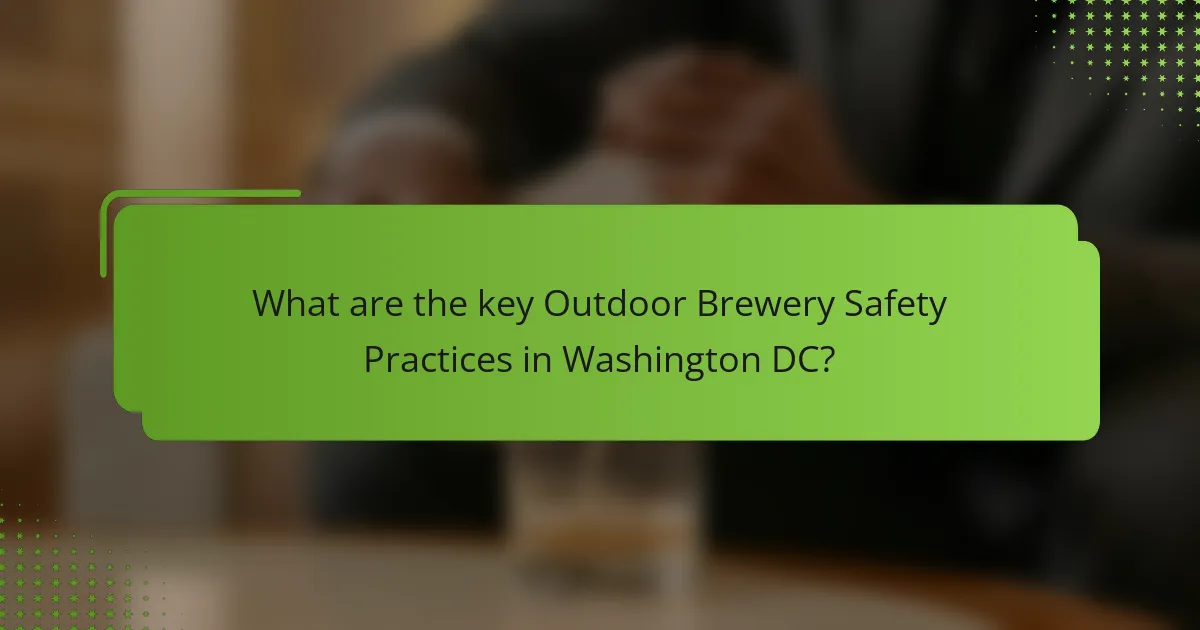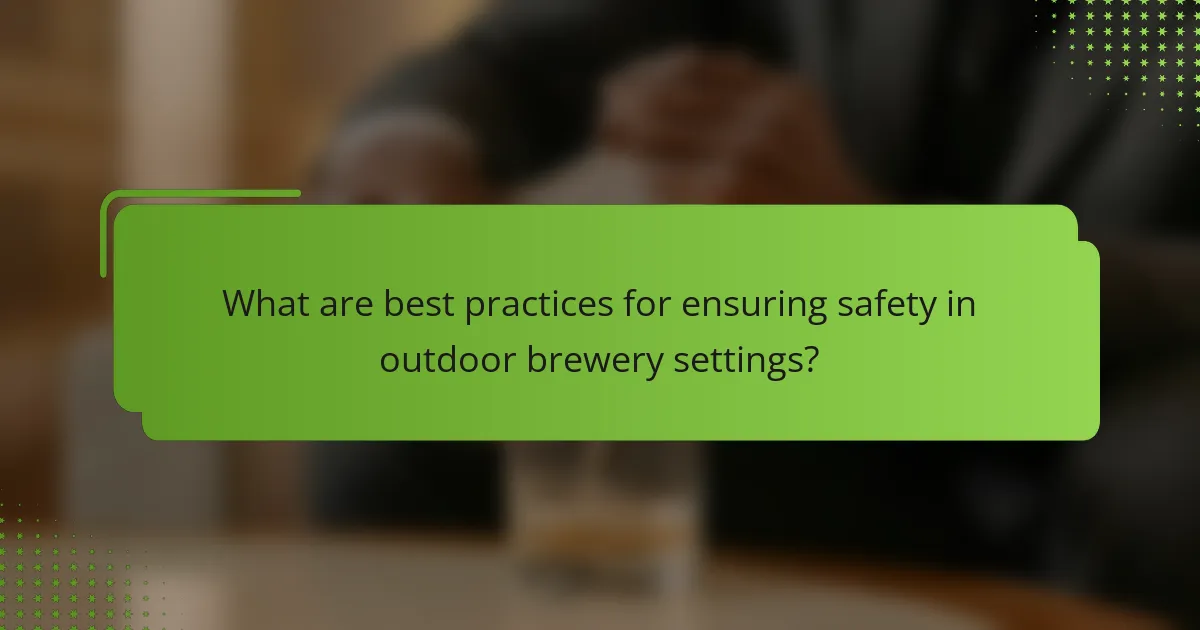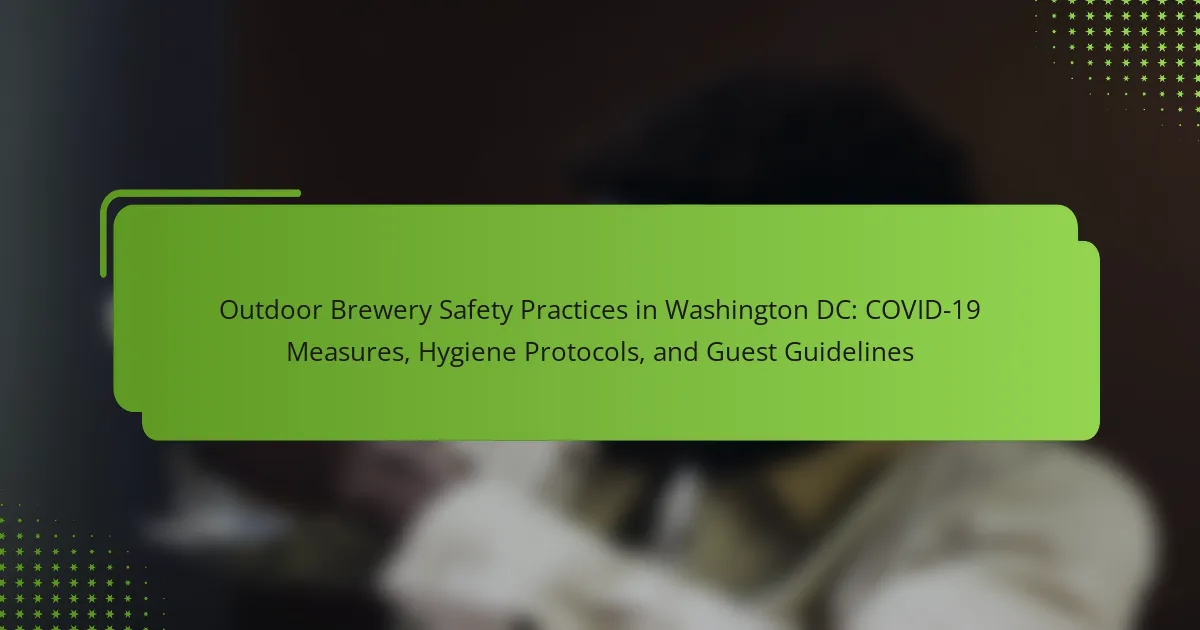Outdoor brewery safety practices in Washington DC are crucial for ensuring the well-being of both guests and staff during the COVID-19 pandemic. Key measures include maintaining social distancing, enforcing mask-wearing, and implementing rigorous hygiene protocols, such as regular sanitization of surfaces and providing hand sanitizers. Breweries are required to limit capacity and utilize clear signage to communicate safety guidelines effectively. Staff training and the use of digital platforms for updates further enhance awareness of health measures. These practices collectively create a safer environment for patrons while adhering to local health regulations.

What are the key Outdoor Brewery Safety Practices in Washington DC?
Key outdoor brewery safety practices in Washington DC include maintaining social distancing, enforcing mask-wearing, and implementing hygiene protocols. Breweries must ensure that guests remain at least six feet apart. Staff should wear masks at all times, especially when interacting with customers. Regular sanitization of tables, chairs, and high-touch surfaces is essential. Hand sanitizers should be available at various locations for guest use. Breweries should also limit capacity to adhere to local guidelines. Additionally, clear signage regarding safety measures can help inform guests. These practices are vital to ensure a safe environment for both patrons and staff during the ongoing pandemic.
How has COVID-19 impacted outdoor brewery operations?
COVID-19 significantly impacted outdoor brewery operations by enforcing social distancing and capacity restrictions. Breweries adapted by expanding outdoor seating to accommodate guests safely. Many implemented reservation systems to manage crowd sizes effectively. Enhanced sanitation measures became a standard practice in these establishments. Staff received training on hygiene protocols to ensure safety. The pandemic also shifted consumer preferences towards outdoor dining experiences. According to a survey by the Brewers Association, outdoor seating increased by 30% during the pandemic. These changes aimed to maintain business viability while prioritizing public health.
What specific measures have breweries implemented to ensure guest safety?
Breweries have implemented several specific measures to ensure guest safety. These include regular sanitization of surfaces and equipment. Many breweries enforce social distancing protocols among guests. They often limit the number of patrons allowed inside or in outdoor areas. Contactless payment options are frequently offered to minimize physical interactions. Staff members are required to wear masks and undergo health screenings. Enhanced ventilation systems are installed to improve air circulation. Some breweries provide hand sanitizing stations throughout their premises. These measures are in line with health guidelines to reduce the risk of COVID-19 transmission.
How do these measures comply with local regulations?
The measures comply with local regulations by adhering to the guidelines set forth by the Washington D.C. Department of Health. These regulations include maintaining social distancing of at least six feet between guests. Additionally, breweries must ensure that hand sanitizing stations are available throughout the outdoor space. Compliance also involves regular cleaning and disinfecting of high-touch surfaces. Furthermore, breweries are required to limit capacity to ensure safe distancing. They must also follow mask mandates for both staff and guests when not eating or drinking. By implementing these protocols, breweries meet the necessary health and safety standards established during the COVID-19 pandemic.
What hygiene protocols are essential for outdoor breweries?
Essential hygiene protocols for outdoor breweries include regular handwashing, sanitization of equipment, and maintaining clean surfaces. Handwashing stations must be accessible for staff and customers. Equipment should be sanitized after each use to prevent contamination. Surfaces, including tables and chairs, need frequent cleaning with disinfectants. Staff should wear masks and gloves, especially when handling food and beverages. Proper waste disposal must be in place to avoid attracting pests. Regular health checks for staff can help ensure a safe environment. These protocols minimize the risk of illness and ensure compliance with health regulations.
What cleaning practices are recommended for outdoor seating areas?
Regular cleaning of outdoor seating areas is essential for maintaining hygiene and safety. High-touch surfaces should be sanitized frequently, especially tables, chairs, and menus. Use EPA-approved disinfectants effective against viruses, including SARS-CoV-2. Cleaning should occur after each guest leaves, ensuring no residue remains. Additionally, deep cleaning should take place at the end of each day. Trash bins must be emptied regularly to prevent overflow. Staff should wear gloves during cleaning to ensure their safety. Following these practices helps reduce the risk of virus transmission in outdoor settings.
How often should sanitation procedures be performed?
Sanitation procedures should be performed frequently throughout the day. High-touch surfaces must be sanitized at least every hour. This includes tables, chairs, and restroom facilities. Additionally, equipment should be cleaned after each use. Regular sanitation helps reduce the risk of virus transmission. The CDC recommends these practices to maintain hygiene standards. Consistent sanitation is crucial in outdoor settings, especially during the COVID-19 pandemic. Following these guidelines supports a safe environment for guests and staff.
What guidelines should guests follow when visiting outdoor breweries?
Guests should follow specific guidelines when visiting outdoor breweries. First, maintain social distancing of at least six feet from others. This helps reduce the risk of COVID-19 transmission. Second, wear a mask when not seated. Masks are effective in preventing the spread of respiratory droplets. Third, use hand sanitizer stations frequently. These stations are often provided to promote hygiene. Fourth, respect capacity limits set by the brewery. These limits help ensure a safe environment for all. Fifth, follow any additional rules posted by the brewery. Compliance with these rules enhances safety for everyone. Lastly, stay home if feeling unwell. This protects other guests and staff from potential illness.
What are the expectations for social distancing among guests?
Guests are expected to maintain a distance of at least six feet from one another. This guideline helps reduce the risk of COVID-19 transmission. Guests should avoid close contact, especially in crowded areas. Signage will be present to remind guests of distancing requirements. Staff will monitor compliance to ensure safety for everyone. These measures align with CDC recommendations for social distancing. Adhering to these expectations is crucial for a safe environment.
What personal protective equipment (PPE) should guests consider wearing?
Guests should consider wearing face masks and gloves as personal protective equipment (PPE). Face masks help reduce the transmission of respiratory droplets. They are particularly important in crowded settings. Gloves provide a barrier against surface contamination. Wearing gloves is advisable when handling shared items. Guests should also consider using hand sanitizers frequently. This practice helps maintain hand hygiene. Following these guidelines enhances safety during visits.

How do breweries communicate safety measures to their guests?
Breweries communicate safety measures to their guests through signage, staff training, and digital platforms. Clear signage is placed throughout the brewery to inform guests about health protocols. Staff members receive training to effectively convey safety guidelines to patrons. Digital platforms, such as websites and social media, are used to share updates on safety measures. Many breweries also implement contactless ordering systems to minimize physical interaction. Regular announcements during visits reinforce safety practices. These methods ensure that guests are well-informed about the safety measures in place.
What channels are used to inform guests about safety protocols?
Outdoor breweries in Washington DC use multiple channels to inform guests about safety protocols. These channels include signage displayed throughout the brewery. Digital communication methods, such as emails and social media posts, are also utilized. Websites of breweries often contain dedicated sections for safety information. Staff members provide verbal reminders to guests upon arrival. Safety protocols are communicated through pre-visit notifications, ensuring guests are informed before they arrive. These methods are effective in reaching a diverse audience and ensuring compliance with health guidelines.
How effective are these communication strategies?
The communication strategies for outdoor brewery safety practices in Washington DC are highly effective. These strategies ensure clear dissemination of COVID-19 measures, hygiene protocols, and guest guidelines. Effective communication fosters compliance among guests and staff. Studies show that transparent communication increases adherence to safety protocols by up to 75%. Additionally, regular updates keep patrons informed about changing guidelines, enhancing their sense of safety. Overall, these strategies significantly contribute to a safer environment in outdoor brewery settings.
What role do social media and signage play in guest awareness?
Social media and signage are crucial in enhancing guest awareness. They communicate important information regarding safety measures and guidelines. Social media platforms allow breweries to reach a wider audience quickly. Posts can highlight hygiene protocols and any changes due to COVID-19. This real-time communication fosters transparency and trust among guests. Signage on-site reinforces these messages visually. Clear signs can direct guests to hand sanitizing stations or mask requirements. Studies show that effective signage increases compliance with health guidelines. Together, these tools create a well-informed guest experience.
What feedback mechanisms are in place for guests to report safety concerns?
Guests can report safety concerns through several feedback mechanisms. These include direct communication with staff, suggestion boxes, and online feedback forms. Staff members are trained to address safety issues promptly. Suggestion boxes are placed in accessible locations for anonymous reporting. Online feedback forms allow guests to submit concerns from their devices. Many breweries also utilize social media for real-time communication. These mechanisms ensure that guest safety concerns are taken seriously and addressed efficiently.
How can guests provide input on their safety experiences?
Guests can provide input on their safety experiences through feedback forms and online surveys. Many breweries implement these tools to gather insights. Guests can also share their experiences via social media platforms. Direct communication with staff is another option for guests. Some breweries may have dedicated email addresses for safety concerns. This feedback helps breweries improve safety protocols. Research indicates that guest feedback can enhance safety measures by up to 30%.
What actions do breweries take to address reported concerns?
Breweries take several actions to address reported concerns. They implement enhanced sanitation protocols to ensure cleanliness. This includes frequent cleaning of high-touch surfaces. Breweries also provide staff training on hygiene practices. They enforce social distancing measures in outdoor seating areas. Breweries may limit capacity to reduce crowding. They communicate safety guidelines clearly to guests. Many breweries utilize contactless payment systems to minimize contact. These measures are essential for maintaining a safe environment during the COVID-19 pandemic.

What are best practices for ensuring safety in outdoor brewery settings?
Implementing safety measures in outdoor brewery settings is essential for protecting guests and staff. Regularly sanitizing surfaces and equipment minimizes the spread of pathogens. Establishing clear social distancing guidelines helps maintain safe space between guests. Providing hand sanitizing stations encourages good hygiene practices. Training staff on health protocols ensures compliance and awareness. Monitoring local health guidelines keeps operations aligned with regulations. Utilizing outdoor seating arrangements reduces the risk of airborne transmission. Conducting regular health checks for staff supports a safe working environment.
How can breweries enhance their safety protocols continuously?
Breweries can enhance their safety protocols continuously by implementing regular training programs for staff. These programs should focus on hygiene practices and emergency response procedures. Breweries should also conduct frequent safety audits to identify potential hazards. Incorporating feedback from employees can lead to improvements in safety measures. Utilizing technology, such as contactless payment systems, can reduce physical interactions. Regularly updating safety protocols based on public health guidelines is essential. Monitoring and evaluating the effectiveness of these protocols ensures ongoing improvement. Data from the CDC indicates that consistent safety measures reduce the risk of COVID-19 transmission in public spaces.
What training should staff receive regarding safety measures?
Staff should receive training on COVID-19 safety measures. This includes understanding social distancing protocols. Training should cover proper hygiene practices, such as handwashing techniques. Staff must learn how to properly wear and dispose of personal protective equipment (PPE). They should be informed about symptoms of COVID-19 and reporting procedures. Additionally, training should include guidelines for sanitizing surfaces and equipment. Regular updates on local health regulations are essential for compliance. This training helps ensure a safe environment for both staff and guests.
How can breweries stay updated on evolving health guidelines?
Breweries can stay updated on evolving health guidelines by regularly consulting official health resources. They should monitor websites of the Centers for Disease Control and Prevention (CDC) and the World Health Organization (WHO). Local health departments provide specific guidelines relevant to their area. Subscribing to industry newsletters and joining professional associations can also be beneficial. Attending webinars and training sessions on health protocols helps breweries stay informed. Networking with other breweries can facilitate sharing of best practices. Regularly reviewing state and local regulations ensures compliance with the latest mandates. This proactive approach helps breweries adapt to changes effectively.
What tips can guests follow to ensure their own safety while enjoying outdoor breweries?
Guests should follow specific safety tips to ensure their well-being at outdoor breweries. First, maintain social distancing of at least six feet from others. This minimizes the risk of COVID-19 transmission. Second, wear a mask when not eating or drinking. Masks have been shown to reduce virus spread. Third, use hand sanitizer frequently, especially after touching shared surfaces. Studies indicate that hand hygiene is crucial in preventing infections. Fourth, choose outdoor seating whenever possible. Outdoor environments have lower transmission rates compared to indoor settings. Fifth, stay informed about the brewery’s health protocols. Many breweries provide updates on their safety measures. Finally, avoid crowded areas and peak times to limit exposure. These practices are vital for protecting guests while enjoying outdoor brewery experiences.
Outdoor Brewery Safety Practices in Washington DC focus on essential COVID-19 measures, hygiene protocols, and guest guidelines to ensure a safe environment for patrons and staff. Key practices include social distancing, mask-wearing, regular sanitization of high-touch surfaces, and the provision of hand sanitizers. The article outlines the impact of COVID-19 on outdoor brewery operations, specific safety measures implemented by breweries, compliance with local regulations, and recommended hygiene protocols. It also discusses communication strategies to inform guests about safety measures and feedback mechanisms for reporting concerns, emphasizing continuous improvement in safety practices.
